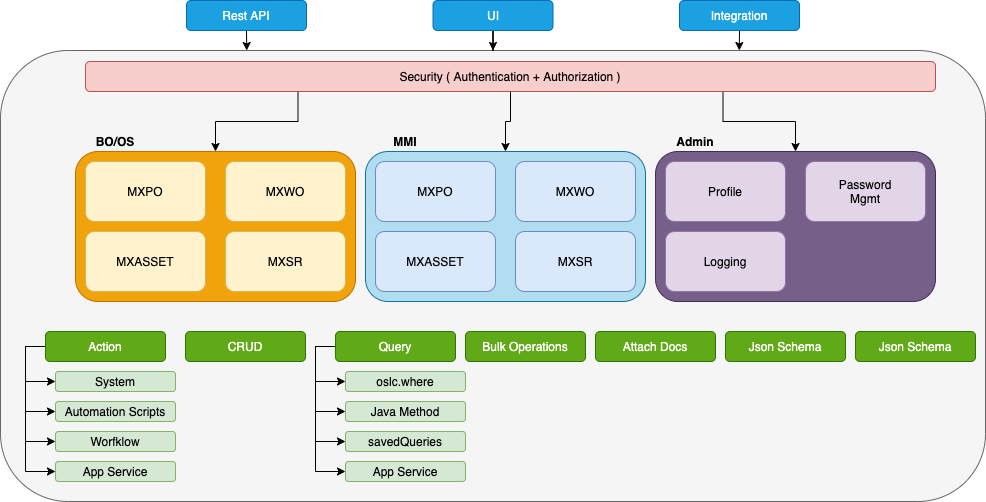IBM Maximo: Dicas de APIs Rest
Arquitetura
- BO/OS: BO/Object Structure
- MMI: Maximo Management Interface
Documentação, Artigos e Technotes
- Documentação: Maximo's REST API (aka JSON API, OSLC API) Documentation
- Documentação: Maximo Manage REST APIs
- Artigo: Send notifications to Slack via Maximo Integration Framework
- Artigo: Custom autoscript end point realizes to access OAuth2 protected resources
URLs
- maximo/oslc/login or /j_security_check
- /maximo/oas3/api.html-> Maximo RESTful API - Swagger
- /maximo/oslc/oas?includeactions=1-> Maximo RESTful API - Swagger include actions
- /maximo/oslc/ -> Default uri os oslc
- /maximo/oslc/apimeta -> APIs Metadata. Metadata for all the object structures that are API eligible
- /maximo/oslc/license -> License Keys
- /maximo/oslc/members -> Server Members, API for the Maximo Management Interface (MMI).
- /maximo/oslc/members/thisserver ->This Server
- /maximo/oslc/products -> Installed Products
- /maximo/oslc/systeminfo -> System Info
- /maximo/oslc/version -> Version
- /maximo/oslc/whoami -> Who am I
- /maximo/oslc/sp -> Service Provider
- /maximo/oslc/os/MXINTOBJECT
- /maximo/oslc/os/MXOBJECTCFG
- /oslc/jsonschemas/jsonschema/<object structure>
GET jsonschema/mxapiwodetail – gets the schema for the OS, but one object at a time. GET jsonschema/mxapiwodetail?oslc.select=* - gets the full schema Support child object schemas GET jsonschema/mxapiasset/assetmeter Support schema views - Get jsonschema/mxapiasset?oslc.select=attr1,rel1.attr2 Mbo schemas GET jsonmboschemas/asset
POST /maximo/oslc/os/mxasset{id}?action=wsmethod:changeStatus
{
"rollToAllChildren": true,
"removeFromActiveSP": true,
"removeFromActiveRoutes": true,
"status": "string",
"changePMStatus": true
}
Headers
| Key | Value | Description |
|---|---|---|
| maxauth=base64(username:password) | required | Username and Password encoded as base64 |
| Content-Type=application/json | - | - |
| Accept=application/json | - | - |
Parameters
| Key | Description |
|---|---|
| uri?lean=1 | simple notation |
| uri?oslc.select | especifica o conjunto de atributos a serem buscados nas estruturas de objetos, bem como nos objetos relacionados. Veja seção abaixo. |
| uri?oslc.where | especifica a cláusula WHERE para filtrar o conjunto de resultados de uma consulta. Veja seção abaixo. |
| uri?oslc.orderBy uri?oslc.orderBy=-attr1,+attr2 |
especifica como os resultados de uma consulta são ordenados. O sinal de (-) para ordem decrescente e sinal de (+) para ordem crescente, sendo que o sinal + deve estar encoded. |
| uri?oslc.paging=true | - |
| uri?oslc.pageSize=N uri?oslc.pageSize=N&stablepaging=true |
especifica os recursos para cada página de uma consulta.
|
| uri?savedQuery=name | Saved query can be SQL, Java, Auto Script. /apimeta/<os name> lists all saved queries for an Object Structure |
| uri?tlrange=-3M&tlattribute=dateattr[=indexdate] |
|
| POST uri?interactive=1 | Handling Yes/No/Cancel interactions |
| GET uri?gbcols=status,count.*,sum.attr1&gbsortby=-count.* |
Aggregation APIs.
Also supports date histograms – yearly/quarterly/monthly/weekly. |
| uri?collectioncount=1 | retorna o totalCount e totalPages na reposta Set mxe.oslc.collectioncount system property to 1, the totalCount and totalPages parameters are included by default as part of the responseInfo. |
| uri?count=1 | only the total count of records that match the query and not the records |
| uri?_dropnulls=0 | To force the response to add null value attributes, API response skips the null value attributes by default |
| uri?_format=xml uri?_format=csv |
type of output |
oslc.select
| Key | Description |
|---|---|
| oslc.select=assetnum,location—mylocation | Apelido para atributo, para resolver conflitos de mesmo nome. Senão adicionado retorna $alias_this_attr$ |
| oslc.select=attr1,attr2,child{attr4,attr5,grandchild{*}} | - |
| oslc.select=attr1,rel1.attr1,rel.rel2{attr1,attr2},rel.rel3.os {*} |
|
| /oslc/os/mxasset?oslc.select=assetnum,status,exp.myreplacecost |
create a object formula called MYREPLACECOST for asset object by using the Object Formula action in the Database Configuration application. The formula is purchaseprice/NVL(priority,1). |
| /oslc/os/mxasset/{id}?oslc.select=assetnum,openwo.actlabhrs._dbmax, ... |
database aggregation (max,min,avg,sum,count, and exists) functions on related MboSets, must add _db prefix. |
| oslc.select=assetnum,status&internalvalues=1 |
Domain internal values. Returns as <attribute name>_maxvalue property. |
oslc.where
| Key | Description |
|---|---|
| uri?oslc.where=attr1 in ["val1","val2"] and attr2>200 | - |
| uri?oslc.where=objectname IN ["WORKORDER","WOACTIVITY] | - |
| uri?oslc.where=usewith="INTEGRATION" | - |
Response Data
{
"members": [{
"href": "uri"
}
...
],
"responseInfo": {
"nextPage": {
"href": "next page uri"
},
"href": "request uri",
"pagenum": 1
}
}

